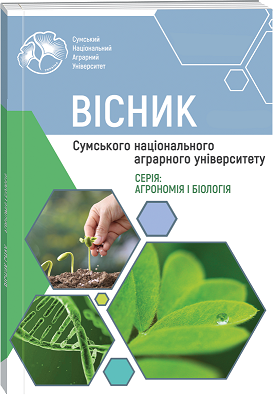FEATURES OF MANIFESTATION OF ADAPTIVE TRAITS IN BREEDING POPULATIONS OF ALFALFA IN SEED PRODUCTION
Abstract
Adaptive traits in alfalfa populations have been studied: plasticity, stability, genetic flexibility, general and specific adaptability in seed use, promising material for its further use in the selection process has been identified. Field, statistical. The research was conducted at the Institute of Irrigated Agriculture of NAAS of Ukraine during 2017–2020 pp. 24 alfalfa populations were studied. Environmental condition indices (Ij) were used to assess growing conditions. The most favorable conditions for the formation of seed productivity were in 2019 (Ij = + 123.87), in 2017 they were unfavorable (Ij = - 24.94), in 2018 – conditions were very unfavorable (Ij = - 98.93). Seed yield in alfalfa genotypes ranged from 169.57 to 243.10 kg/ha. There was a high positive relationship between seed yield in alfalfa populations (r = 0.768–0.882) with the index of genetic flexibility (Gf), total adaptive capacity (OACi) (r = 0.799–0.891) and adaptability coefficient (KA) (r = 0.799–0.891). On the base of data analyze of seed productivity of alfalfa population for the first year its populations can be divided into three groups: intensive, stable and adapted types on the parameters of adaptive capacity and biplot analysis. The best stable populations were: Mg / CP-11 and J. / CP-11, intensive type – LR / H, Primorka / Sin (s) and adapted to different conditions – Sin (s) / Primorka and A.-N .d. № 15. Comprehensive assessment of populations on alfalfa seed yield and adaptability parameters using different methods and biplots analysis allowed to identify genotypes with high potential productivity and the greatest adaptability. These include genotypes: stable Mg / CP-11 and J. / CP-11, intensive type – LR / H, Primorka / Sin (s) and adapted to different conditions – Sin (s) ./ Primorka and A.-N.d. № 15, which should be used in the selection process of alfalfa for adaptability in the creation of new varieties.
References
2. Aseeva, T. A. & Zenkina, K. V. (2019). Adaptivnost' sortov jarovoj tritikale v agrojekologicheskih uslovijah srednego Priamur'ja. Rossijskaja sel'skohozjajstvennaja nauka, 1, 9–11. doi: 10.31857/S2500-2627201919-11 (in Russian).
3. Ashraf, M. (2010). Inducing drought tolerance in plants: Recent advances. Biotech. Adv., 28, 169–183.
4. Ayalneh, T., Letta, T. & Abinasa, M. (2013). Assessment of stability, adaptability and yield performance of bread wheat (Triticum aestivum L.) cultivars in South Eastern Ethiopia. J. Agric. & Environ. Sci, 13(7), 885–890. doi: 10.5829/idosi.aejaes.2013.13.07.1950.
5. Bajkalova, L. P. & Serebennikov, Ju. I. (2014). Ocenka adaptivnogo potenciala sortov jachmenja v Kanskoj lesostepi [Assessment of the adaptive potential of barley varieties in the Kansk forest-steppe]. Vestnik KrasGAU, 10, 93–97 (in Russian).
6. Bazalіj, V. V. (2004). Principi adaptivnoї selekcії ozimoy pshenycі v zonі Pіvdennogo Stepu [Principles of adaptive selection of winter wheat in the Southern Steppe zone]. Ajlant, Herson, 243. (in Ukrainian).
7. Demidov, O. A., Homenko, S. O., Chugunkova, T. V. & Fedorenko, І. V. (2019). Urozhajnіst' ta gomeostatichnіst' kolekcіjnih zrazkіv pshenicі jaroї. Vіsnik agrarnoї nauki, 9(798), 47–51 (in Ukrainian).
8. Eberhart, S. A. & Russell, W. A. (1966). Stability parameters for comparing varieties. Crop Science, 6(1), 36–40.
9. Giancarla, V., Madosa, E., Ciulca, S., Ciulca, A., Petolescu, C., & Bitea, N. (2010). Assessment of drought tolerance in some barley genotypes cultivated in West part of Romania. J. Hortic. For. Biotechnol., 14(3), 114–118.
10. Goncharenko, A. A. (2005). Ob adaptivnosti i jekologicheskoj ustojchivosti sortov zernovyh kul'tur [On the adaptability and ecological sustainability of grain varieties]. Vestnik RASHN, 6, 49–53 (in Russian).
11. Goncharenko, A. A. (2016) a. Sravnitel'naja ocenka adaptivnogo potenciala sortov zernovyh kul'tur i zadachi selekcii [Comparative assessment of the adaptive potential of grain varieties and breeding problems]. Selekcija rastenij: proshloe, nastojashhee i budushhee. Sbornik materialov I Vserossijskoj nauchno-prakticheskoj konferencii s mezhdunarodnym uchastiem, posvjashhjonnoj 140-letiju NIU «BelGU» i 100-letiju so dnja rozhdenija selekcionera, uchenogo i pedagoga, doktora sel'skohozjajstvennyh nauk, professora Shhelokovoj Zoi Ivanovny, 46–48 (in Russian).
12. Goncharenko, A. A. (2016) b. Jekologicheskaja ustojchivost' sortov zernovyh kul'tur i zadachi selekcii [Environmental sustainability of grain varieties and breeding objectives]. Zernovoe hozjajstvo Rossii, 2(44), 31–36 (in Russian).
13. Habibullin, K. N., Ashiev, A. R., & Skulova, M. V. (2020). Ocenka adaptivnosti I produktivnosti rastenij kollekcii gorokha posevnogo [Assessment of the adaptability and productivity of plants in the collection of sowing peas]. Zernovoe khozyajstvo Rossii. 1(67), 33–36 (in Russian). doi: 10.31367/2079-8725-2020-67-1-33-36
14. Harrison, M. T., Tardieu, F., Dong, Z., Messina, C. D. & Hammer, G. L. (2014). Characterizing drought stress and trait influence on maize yield under current and future conditions. Glob. Change Biol, 20(3), 867–878. doi: 10.1111/gcb.12381.
15. Hudzenko, V. N. (2019). Statisticheskaja i graficheskaja (GGE biplot) ocenka adaptivnoj sposobnosti i stabil'nosti selekcionnyh linij jachmenja ozimogo [Statistical and graphic (GGE biplot) assessment of adaptive capacity and stability of breeding lines of winter barley]. Vavilovskij zhurnal genetiki i selekcii, 23(1), 110–118 (in Russian). doi: 10.18699/VJ19.469
16. Ignat'ev, S. A., & Regidin, A. A. (2019). Ocenka parametrov adaptivnosti kollekcionnykh obrazcov ehsparceta [Assessment of the parameters of adaptability of collection specimens of esparcet]. Zernovoe khozyajstvo Rossii, 3(63), 53–58. doi: 10.31367/2079-8725-2019-63-3-53-58 (in Russian).
17. Kil'chevskij, A. V. & Hotyleva, L. V. (1985). Metod ocenki adaptivnoj sposobnosti i stabil'nosti genotipov, differencirujushhej sposobnosti sredy [Method for assessing the adaptive ability and stability of genotypes, the differentiating ability of the environment]. Soobshhenie I. Obosnovanie metoda. Genetika, XXI(9), 1481–1489 (in Russian).
18. Kil'chevskij, A. V. & Hotyleva, L. V. (2008). Geneticheskie osnovy selekcii rastenij [Genetic bases of plant selection]. V 4 t. T. 1. Obshhaja genetika rastenij. Belorus. nauka, Minsk, 551 (in Russian).
19. Kordjum, E. L. & Dubina, D. V. (2015). Plastichnіst' ontogenezu sudinnih roslin :molekuljarnі, klіtinnі, populjacіjnі ta cenotichnі aspekti. Vіsn.NAN Ukraїni, 7, 32–36. http://nbuv.gov.ua/UJRN/vnanu_2015_7_7 (in Ukrainian).
20. Kurkova, I. V., & Fokin, S. A. (2018). Ocenka adaptivnoj sposobnosti i ekhologicheskoj plastichnosti sortov i sortoobrazcov yarovogo yachmenya amurskoj selekcii [Assessment of the adaptive capacity and ecological plasticity of verieties and varieties of spring barley of the Amur selection]. Vestnik KraSGAU, 2, 16–21 (in Russian).
21. Latrach, L., Farissi, M., Mohammed, M., Makoudi, B., Bouizgaren, A. & Ghoulam, C. (2014). Growth and nodulation of alfalfa-rhizobia symbiosis under salinity: electrolyte leakage, stomata conductance, and chlorophyll fluorescence. Turkish Journal of Agriculture and Forestry, 38, 320–326. doi:10.3906/tar-1305-52.
22. Litun, P. P. (1980). Vzaimodejstvie genotip-sreda v geneticheskih issledovanijah i sposoby ego izuchenija [Genotypeenvironment interaction in genetic research and methods of its study]. Problemy otbora i ocenki selekcionnogo materiala. K, Naukova dumka, 63–93 (in Russian).
23. Lozinskyi, M. V. (2018). Adaptyvnist selektsiinykh nomeriv pshenytsi ozymoi, otrymanykh vid skhreshchuvannia riznykh ekotypiv za kilkistiu koloskiv v holovnomu kolosi [Adaptability of selection numbers of winter wheat, taken from different types of growing varieties for a number of spikes at the head spike]. Ahrobiolohiia, 1, 233–243 (in Ukrainian).
24. Mel'nik, A. V., Roman'ko, Ju. O. & Roman'ko, A. Ju. (2020). Adaptivnij potencіal і stresostіjkіst' suchasnih sortіv soyi [Adaptive potential and stress resistance of modern soybean varieties]. Tavrіjs'kij naukovij vіsnik, 113, 85–91. doi: 10.32851 /2226-0099.2020.113.12 (in Ukrainian).
25. Orljuk, A. P. & Goncharova, K. V. (2002). Adaptivnij і produktivnij potencіali pshenicі [Wheat adaptive and productive potential]. Ajlant, Herson, 275 (in Russian).
26. Popolzuhin, P. V., Vasilevskij, V. D., Gajdar, A. A., Kuz'mina, E. S. & Parshutkin, Ju. Ju. (2018). Adaptivnyj potenial sortov mjagkoj jarovoj pshenicy raznyh grupp spelosti v juzhnoj lesostepi Zapadnoj Sibiri. Sostojanie i perspektivy nauchnogo obespechenija APK Sibiri: Sbornik nauchnyh statej, posvjashhennyj 190-letiju opytnogo dela v Sibiri,100-letiju sel'skohozjajstvennoj nauki v Omskom Priirtysh'e i 85-letiju obrazovanija Sibirskogo NII sel'skogo hazjajstva, 201–204. (in Russian).
27. Popov, S. I., Leonov, O. Yu., Popova, K. M., & Avramenko, S. V. (2019). Ecological plasticity of winter wheat varieties depending on root nitrogen nutrition in the eastern Forest-Steppe of Ukraine. Plant Varieties Studying and Protection, 15(3), 296–302 (in Ukrainian). doi: 10.21498/2518-1017.15.3.2019.181087
28. Postolati, A. A., Sergej, T. P., & Pleshka, A. V. (2016). Uroven’ adaptivnoj sposobnosti i stabil’nosti razlichnykh genotipov Triticum aestivum L. v usloviyakh Bel’skoj stepi [The level of adaptive ability and resistance of different genotypes of Triticum aestivum L. in the conditions of the Belskaya steppe]. Ştiinţa agricolă, 1, 26–30 (in Russian).
29. Surin, N. A., Zobova, N. V., Ljahova, N. E., Neshumaeva, N. V., Plehanova, L. V., Chuslin, A. A., Onufrienok, T. V., Gerasimov, S. A. & Lipshin, A. G. (2016). Istochniki cennyh priznakov v selekcii jachmenja na adaptivnost' [Sources of valuable traits in barley breeding for adaptability]. Dostizhenija nauki i tehniki APK, 30(6), 36–40 (in Russian).
30. Tyshchenko, A. V., Tyshchenko, O. D., & Liuta, Yu. O. (2021). Otsinka henotypiv liutserny za nasinnievoiu produktyvnistiu na posukhostiikist [Assessment of alfalfa genotypes for their productivity on dryness]. Tavriiskyi naukovyi visnyk, 120. 155–168 (in Ukrainian). doi: 10.32851/2226-0099.2021.120.21
31. Tyshchenko, A. V., Tyshchenko, O. D., Liuta, Yu. O., & Piliarska, O. O. (2021). Adaptyvna zdatnist – vazhlyva oznaka v selektsii Roslyn [Adaptive ability is an important feature in plant breeding]. Zroshuvane zemlerobstvo: mizhvidomchyi tematychnyi naukovyi zbirnyk. VD «Helvetyka», Kherson, 75, 101–109 (in Ukrainian).
32. Vasconcelos, E. S., Barioni Júnior, W., Cruz, C. D., Ferreira, R. de P., Rassini, J. B. & Vilela, D. (2008). Alfalfa genotype selection for adaptability and stability of dry matter production. Acta Sci. Agron. 30, 339–343. doi: 10.4025/actasciagron.v30i3.3511.
33. Wang, Z., Ke, Q, Kim, M. D., Kim, S. H., Ji, C. Y., & Jeong, J. C. (2015). Transgenic Alfalfa Plants Expressing the Sweetpotato Orange Gene Exhibit Enhanced Abiotic Stress Tolerance. PLoS ONE, 10(5), e0126050. doi: 10.1371/journal.pone.0126050
34. Zajceva, І. O. (2015). Analіz fenoritmіki ta adaptivnih vlastivostej klenіv v umovah іntrodukcії u Stepovomu Pridnіprov'y [Analysis of phenorhythmics and adaptive properties of maples in the conditions of introduction in the Steppe Dnieper]. Vіsnyk Dnіpropetrovs'kogo derzhavnogo agrarno-ekonomіchnogo unіversitetu. 6–12 (in Ukrainian).
35. Zhuchenko, A. A. (2009). Adaptivnoe rastenievodstvo jekologo-geneticheskoe osnovy. Teorija i praktika [Adaptive plant growing ecological-genetic basis. Theory and practice]. V 3-h t. Agrorus, M., 2, 1104 (in Russian).

 ISSN
ISSN  ISSN
ISSN 


